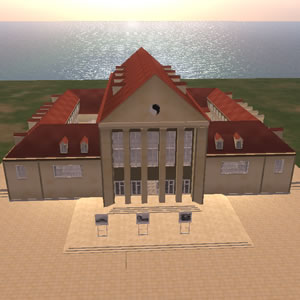The virtual theatres
Bayreuth Festspielhaus

- The Bayreuth Festspielhaus on Theatron Island.
In May 1872 Wagner laid the foundation stone for the Bayreuth Festspielhaus. The theatre, built with money from private sources and above all from King Ludwig II, was specially designed for the performance of Wagner’s operas and was envisaged as an 'illusion machine' in which the spectator would experience a mythical world.
The location was carefully chosen to enhance the exclusive character of the venue. The theatre is situated outside the town of Bayreuth on a hilltop surrounded by woods. Literally and symbolically the structure rises above everyday life and functions as an island where the visitor can concentrate fully on the theatrical experience. This is further reinforced by the effort required to reach the theatre on foot. After leaving the confinement of the city the road climbs slowly until, after turning a bend, the theatre suddenly appears and the city behind disappears from view. In this respect, some writers refer to a visit of the Festspielhaus in terms of a pilgrimage.
The inner structure of the theatre is designed around Wagner's ideal of a 'Gesamtkunstwerk', where the spectators experience the performance in an undisturbed manner or 'as if they were dreaming'. In practice, this meant that every seat in the house would have a good, unobstructed view of the stage and that the technical facilities should be very elaborate.
The theatre's most important features are:
The auditorium
Fan shaped with a steep rise, it ensures that every seat has an excellent view of the stage.
The orchestra
One of the most revolutionary elements of the theatre is a submerged orchestra pit, partly situated under the stage.
The proscenium arch
The arch is in fact a triple arch, and together these proscenia form a kind of tunnel through which the spectators look at the stage. Because the distance to the stage is not clear, it is possible to create optical illusions with regard to the size of people and objects.
How do I view this theatre?
To visit the Odeon of Agrippa in Second life please navigate to the Theatron 3 viewing platform then select the theatre to be rezzed from the Control panel.